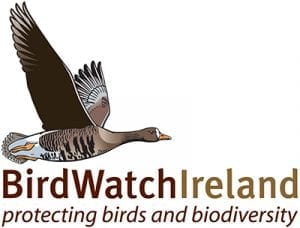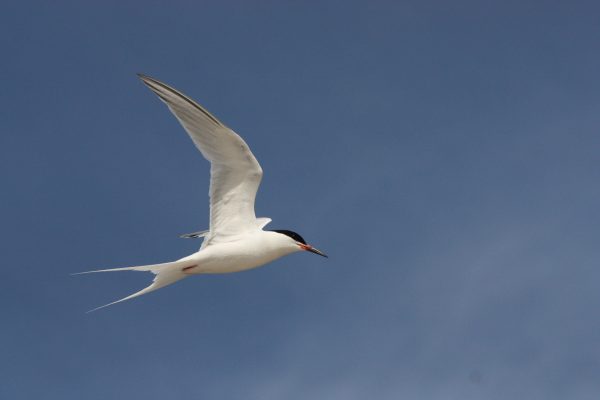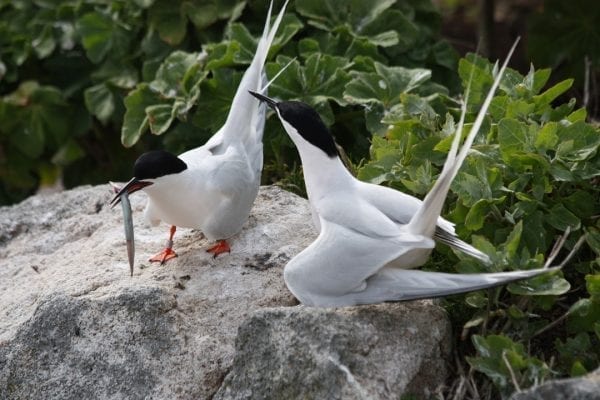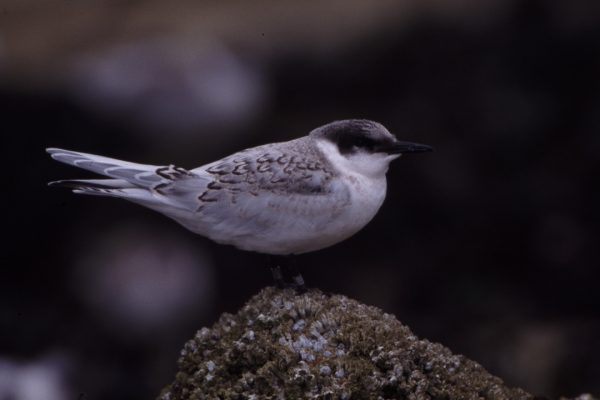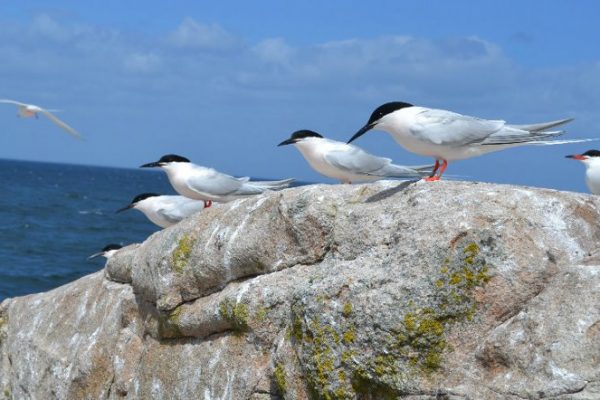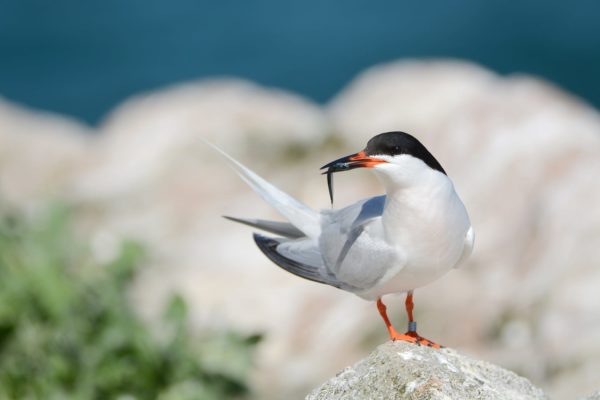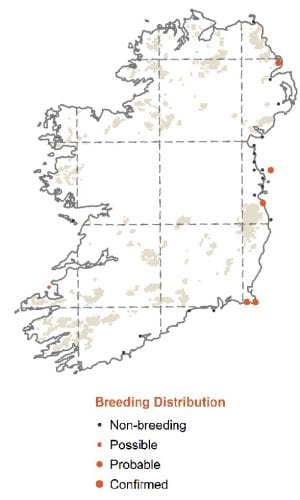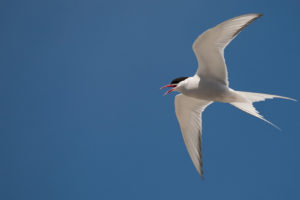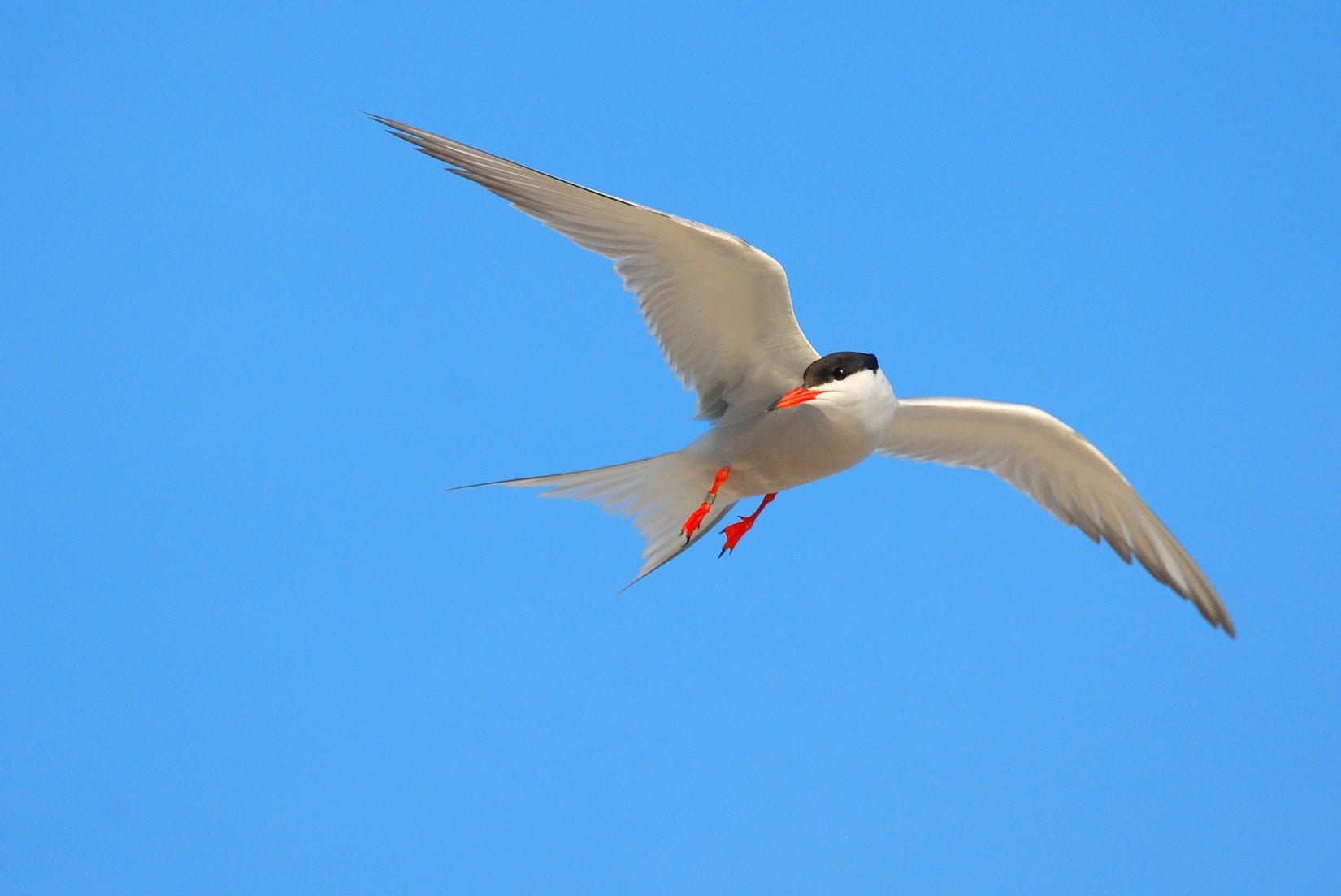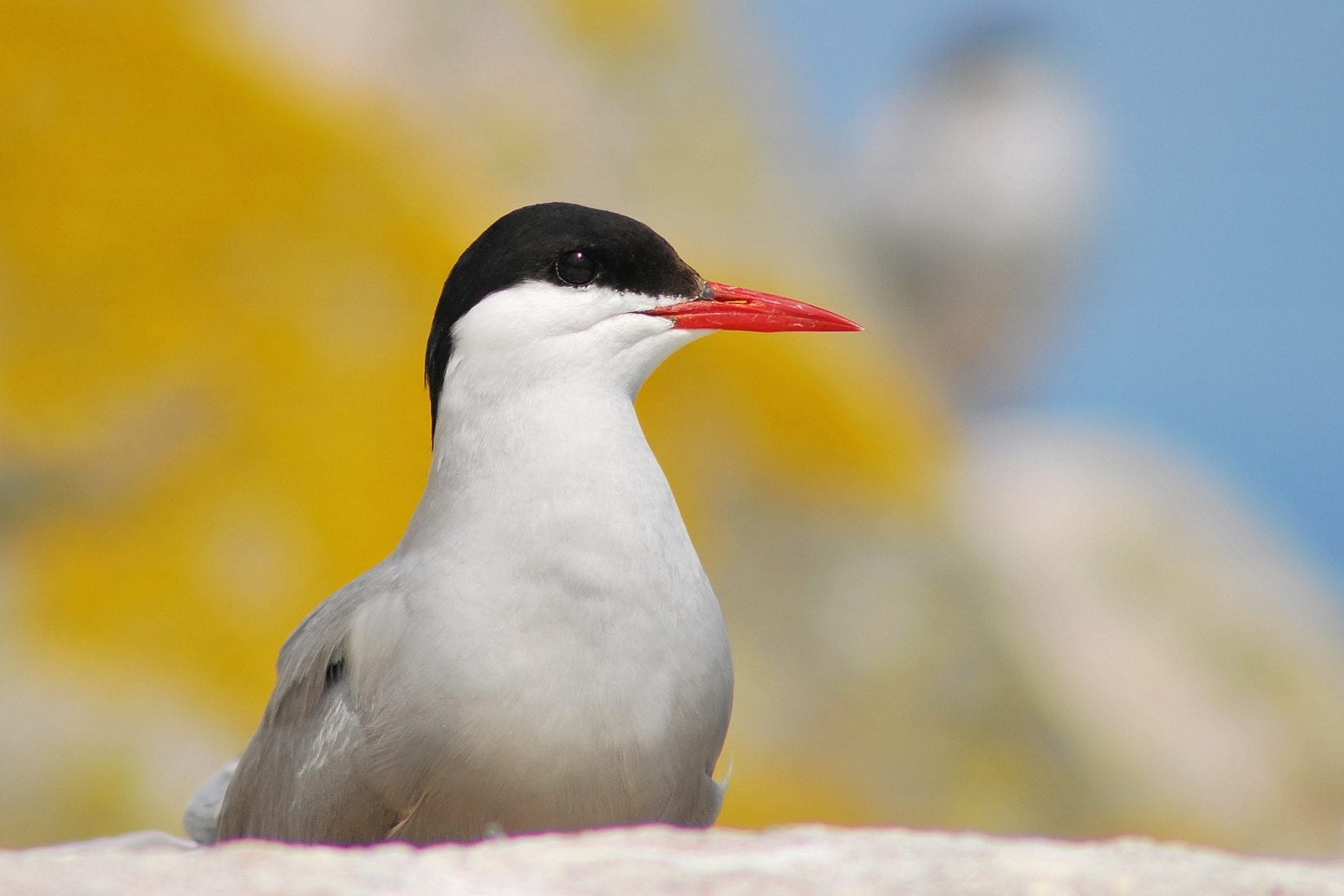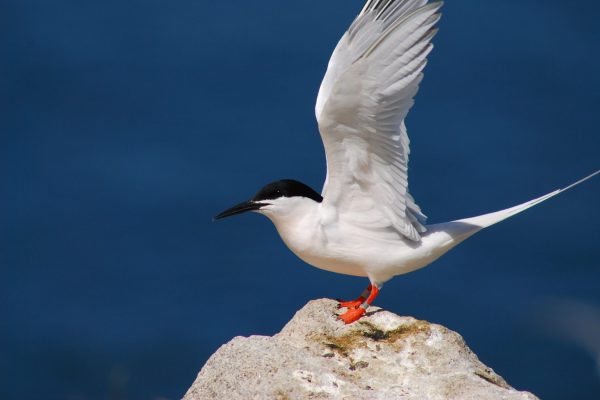
Roseate Tern
| Irish Name: | Geabhróg rósach |
| Scientific name: | Sterna dougallii |
| Bird Family: | Terns |
amber
Conservation status
Conservation status
Status
Rare summer visitor from April to October, the majority breeding at two sites in the Irish Sea, with another colony in Wexford.
Identification
Only seen over the sea. Slender seabird with narrow, pointed wings, long forked tail and long, pointed bill. Bill all dark with a red base when breeding. Grey above and white below, dark cap to head. Flight light and buoyant, can hover briefly over the sea before diving in, dives in with a distinctive angled powerful dive. A slight, elegant tern which is similar to Common and Arctic Terns. Told apart by flight action, more rapid and shallower wingbeats with shorter wings giving a more direct looking flight. Birds in adult summer plumage are very pale, much paler than other terns, with a faint rosy tinge to the upperparts. Legs are long and bright red. Tail steamers very long. Lacks dark trailing edge to primaries. Winter plumage, like all terns is different from breeding plumage. Adult winter plumage develops white forehead and dark carpal bar. Juvenile birds have bold patterns to upperparts with dark legs and bill. First winter birds similar to adults but with some retained juvenile feathers.
Voice
Calls either quick wader like "kerrick" (not unlike Sandwich Tern) or a deep, harsh "ach".
Diet
Chiefly marine fish.
Breeding
Nest colonially on the ground. Restricted to two main colonies in Ireland, one on the island of Rockabill, off Skerries, Co. Dublin and one at Lady's Island, near Rosslare, in Co. Wexford. Birds have bred at other sites recently, for example on Dalkey Island, Co. Dublin and on the Blasket Islands Co. Kerry. Rockabill holds the most important colony in Europe with up to 1,200 pairs of birds. The colony at Lady's Island is much smaller with around a hundred pairs.
Wintering
Winters in west Africa.
Monitored by
Roseate Terns are monitored annually at their breeding colonies on Rockabill Island and Lady’s Island Lake. Also all-Ireland tern survey in 1995, and through breeding seabird surveys. Breeding seabirds are monitored through breeding seabird surveys carried out every 15-20 years.
Blog posts about this bird
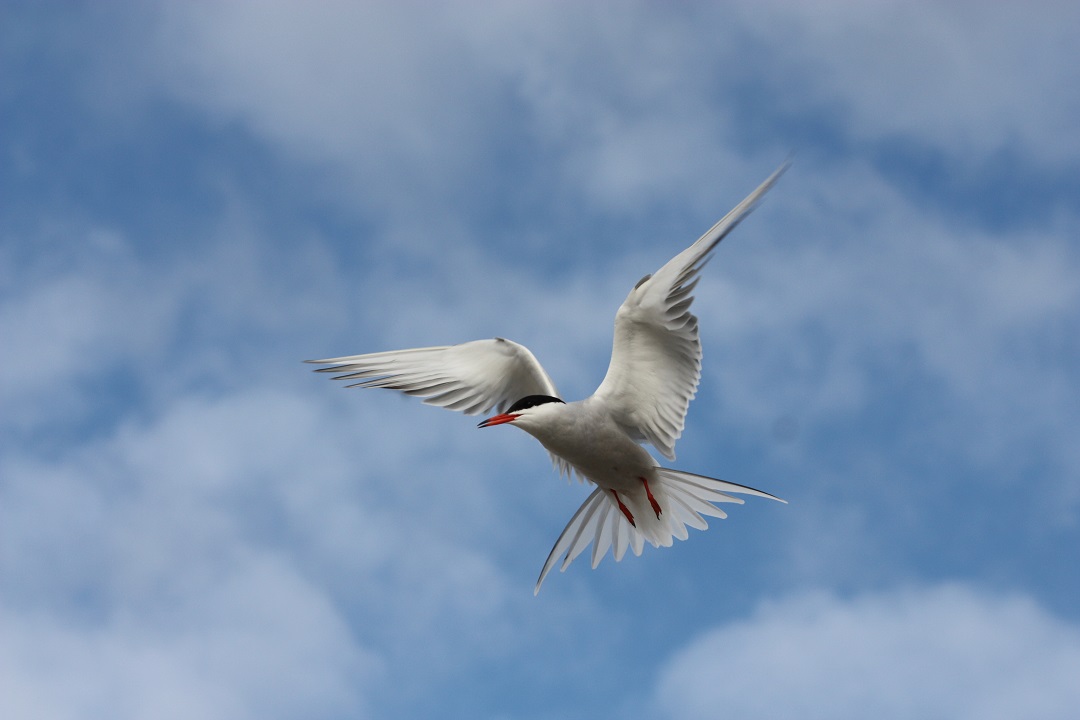
Devastating Bird Flu impacts on Irish seabirds revealed in new study
A new study has revealed the devastating toll of the 2023 bird flu outbreak on Ireland’s tern species at their most important colonies, with Common Terns in particular suffering huge losses.
The recent highly pathogenic avian influenza (HPAI) H5N1 outbreak was the worst ever seen in Ireland, the UK and Europe. Details of the 2023 outbreak in Ireland, the number of birds that died at key breeding colonies, and the effect it has had on nesting numbers in 2024, have been published in the journal Bird Study by staff of BirdWatch Ireland and the National Parks and Wildlife Service. It focuses on colonies in Dublin (Rockabill Island, Dublin Port, Dalkey Island) and Wexford (Lady’s Island Lake) which have been subject to successful conservation efforts for decades, and the bird flu outbreak has come as a huge setback.


The full study entitled "A case study of the 2023 highly pathogenic avian influenza (HPAI) outbreak in tern (Sternidae) colonies on the east coast of the Republic of Ireland" was published in the journal Bird Study and can be accessed here.
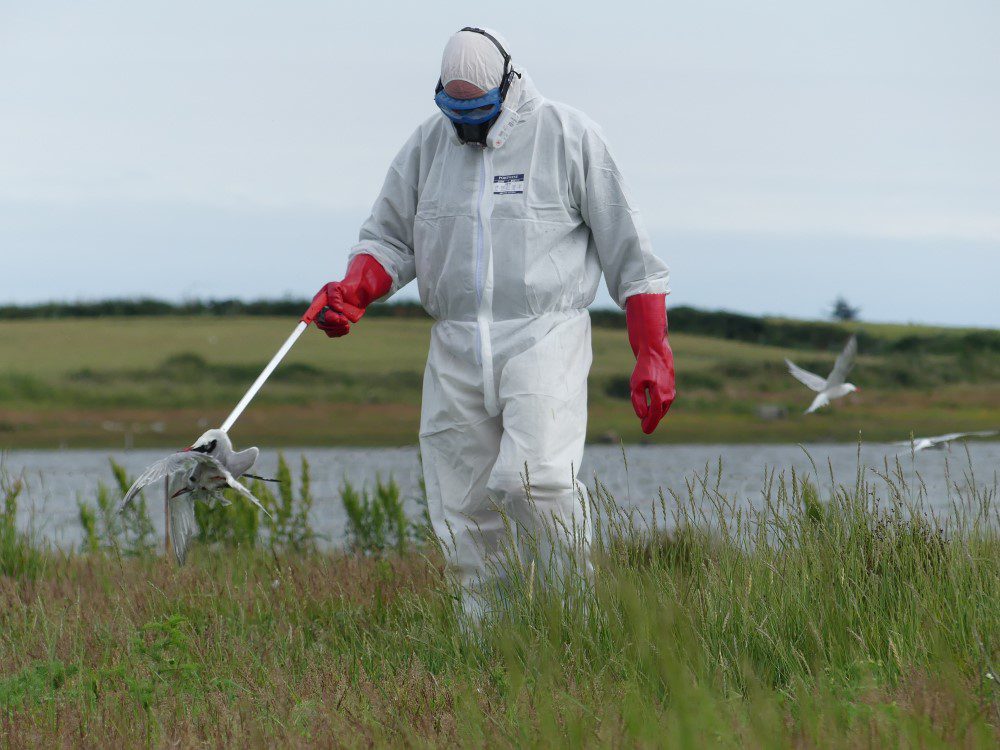
A BirdWatch Ireland Tern Warden removes dead birds during the 2023 avian flu outbreak.
Common Terns suffered very high mortality across all colonies in 2023, with over 700 adult birds and over 1,100 chicks found dead by wardens in colonies at Rockabill, Dublin Port and Lady’s Island Lake. Many more will have died at sea and elsewhere along the coast and not been found, and a census of nests this year recorded a devastating loss of 1,250 breeding pairs across the colonies. In the case of Dublin Port, the colony was halved in a single year, representing the lowest number of nests in 19 years, and similarly the lowest on Rockabill Island since 2003. “The experience of visiting the colony during the outbreak and seeing so many dead and dying birds was really difficult,” said Helen Boland, manager of the Dublin Bay Birds Project. "We’re used to visiting the colony when it’s full of life, so to see so many lost in such a short space of time really had us worried about the future of the species. Terns are long-lived birds that only lay a small number of eggs per year, so losing adult birds is much more damaging to the population than having a bad breeding season.”Arctic Tern. Photo: Kevin Murphy
Arctic Terns were down by 160 breeding pairs, a 20% decline, across the colonies this year due to avian flu. The small colony at Dalkey Island suffered complete breeding failure early in summer 2023 due to rat predation, and this appears to have saved them from contracting avian flu as the birds had deserted before the virus reached Ireland. Arctic Terns lead a very challenging life, not just when trying to find safe places to nest on the Irish coast, but they migrate to Antarctica in the winter – a round trip of nearly 100,000km per year. They have been struggling to nest successfully at some key colonies in recent years, largely due to predation. This, coupled with the fact that Arctic Terns lay fewer eggs than Common Terns, means their recovery is expected to be much slower. Ireland holds 95% of the entire European population of the rare Roseate Tern, concentrated at Rockabill island in Dublin and Lady’s Island Lake in Wexford. Having so many birds at only two sites makes them particularly vulnerable to problems like disease, and their only colony in Britain had already been hit by bird flu in both 2022 and 2023. Despite 65 adult birds and 135 chicks being found dead in Irish colonies during the 2023 outbreak, this didn’t translate into significant losses this year; Lady’s Island was down by 31 pairs, but Rockabill managed to increase by 75 pairs. “The Roseate Tern numbers this year were a pleasant surprise and higher than we expected considering the losses we know came from avian flu,” said Dr. Steve Newton, BirdWatch Ireland’s Senior Seabird Conservationist. “It seems that the high number of chicks fledged in recent years means that recruitment of young birds into the colony was higher than the number of birds lost to bird flu. We’re still expecting to see slow or stalled population growth in the next few years, but it could have been much worse for the Roseates." The Sandwich Tern is Ireland’s largest species of tern, and over 1,500 pairs nest in Wexford. Sandwich Tern colonies all over the UK and Europe were hit with avian flu in 2022, but the virus didn’t reach Irish colonies that year. Nesting numbers last year indicate that Irish Sandwich Terns had suffered mortality on migration and in the wintering grounds however, with a loss of 300 pairs. It is assumed the remaining birds had developed some level of immunity to the virus and therefore escaped summer 2023 relatively unscathed, and actually bounced back to pre-flu numbers this year. This provides some encouragement that the birds can bounce back quickly, though it may simply be that the increase in birds is a result of immigration from other colonies.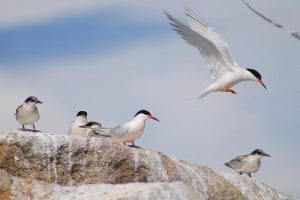
Roseate Terns: Photo: Brian Burke.
Conservation staff of BirdWatch Ireland and NPWS began summer 2024 with a sense of trepidation that bird flu might return, but thankfully there were no signs of it in any of the colonies and most managed to have a successful breeding season this year. With only half the number of nesting pairs it had in 2023, the Dublin Port Tern colony had its most successful breeding season ever, with most pairs managing to fledge two chicks. Elsewhere, Roseate Terns at Rockabill did well, fledging at least one chick on average per pair. The Common Terns at Rockabill, and all tern species at Lady’s Island fared ok but generally faced problems with predation by gulls and foxes, amongst other species, and their greatly reduced numbers may have left them more vulnerable to predation. The long-term tern conservation work by BirdWatch Ireland and the National Parks and Wildlife Service, and long-term support from Dublin Port Company, mean we are well-placed to facilitate recovery at the east coast tern colonies, but avian flu likely impacted west-coast and inland tern sites too. The colonies discussed here are the most important ones nationally for these four tern species and the impact of avian flu emphasizes the importance of not having ‘all of our eggs in one basket’. BirdWatch Ireland’s new Strategy outlines our intention to expand our work to inland and west-coast tern colonies and help secure the status of these species all over the country. Despite calls from BirdWatch Ireland, the Republic of Ireland has yet to develop a formalised plan for the monitoring and management of HPAI in wild birds. The role of various state agencies in such an outbreak is not clear, with some seemingly prioritizing impacts on livestock, others on potential public health implications, but little in the way of monitoring and managing the impact on wild birds. In the absence of comprehensive guidelines, regular meetings between BirdWatch Ireland and the NPWS proved invaluable in 2023. These meetings facilitated a comprehensive and adaptive approach as new guidance emerged from authorities in the UK and Europe and as the HPAI situation developed. It also allowed for a range of precautions to be implemented to minimise the risk of spreading the virus within or between colonies, or to people, while maintaining conservation efforts and long-term monitoring. This paper makes several key recommendations for future HPAI management and procedures in Ireland. It calls for the establishment of a more direct relationship between DAFM, NPWS and BirdWatch Ireland to allow for a more strategic response to outbreaks; the clarification of roles and responsibilities across all relevant government bodies; better resourcing to manage outbreaks and an increase in annual monitoring at Irish seabird colonies wherever possible to help ensure that threats such as HPAI can be monitored in real-time. It is vital that changes are enacted without delay, not only to prevent future seabird losses in the 2025 breeding season, but also to protect the many waterbird species that winter in Ireland and are too at serious risk from HPAI. Despite two cases of avian flu in Little Terns in Ireland, the species escaped largely unscathed and almost all colonies reported increased nesting numbers in 2024. We will report on the Little Tern breeding season in the coming weeks.The full study entitled "A case study of the 2023 highly pathogenic avian influenza (HPAI) outbreak in tern (Sternidae) colonies on the east coast of the Republic of Ireland" was published in the journal Bird Study and can be accessed here.
The Rockabill Tern conservation project is a joint project between the National Parks & Wildlife Service and BirdWatch Ireland. https://www.npws.ie/
The Dublin Port Tern Conservation project is funded by Dublin Port Company as part of BirdWatch Ireland's 'Dublin Bay Birds Project'. https://www.dublinport.ie/
The Tern conservation project at Lady's Island Lake is a National Parks & Wildlife Service project, delivered by BirdWatch Ireland after a competitive tender process. https://www.npws.ie/
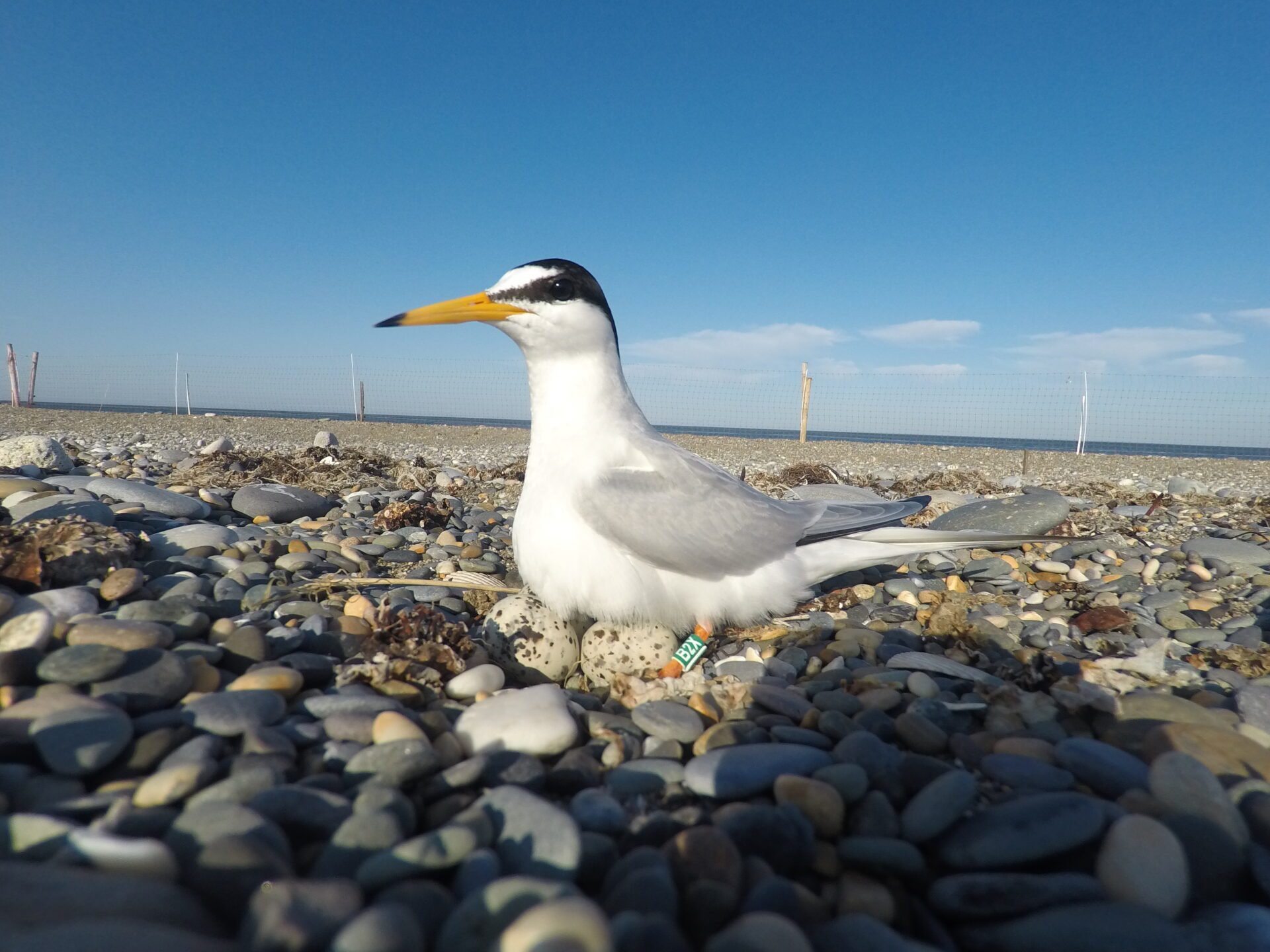
Highs and Lows for Kilcoole Little Terns in 2024
There is no doubt that turning the tide against biodiversity loss is an uphill battle but despite the worrying trends for many species, there is proof out there that we can halt and reverse declines. Indeed, well-resourced, science-based and longstanding conservation projects truly work, and the Kilcoole Little Tern Project is a shining example of this. It is a National Parks and Wildlife Service (NPWS) project, run by BirdWatch Ireland to date.
Of course, every season comes with surprises and 2024 was no exception. There is usually some predictability around the dates the Little Terns arrive back from Africa, and we aim to have the colony fencing and hide in place by the time the first eggs are being laid. The Terns had other plans this year though.
“The season kicked off surprisingly early. The first egg was discovered on the 9th of May. Usually, the 14th or 15th would be considered early so we were caught off guard, in a positive way. We were still in set-up mode at that stage,” explains Brian Burke, Coordinator of the Kilcoole Little Tern Project.
“When that happens, you have to be careful when setting up the fencing to not cause disturbance. We had to tailor what we were doing to ensure that we didn’t keep them off the nests for too long. Thankfully, everything went smoothly and chicks from all of those early nests hatched successfully.”

 It is difficult to pinpoint why some terns arrive early. However, it is likely influenced at least in part by the Kilcoole project itself.
“Kilcoole is a reliable and successful place for them to nest, not because there is anything particularly unique about the beach, but because of the project and the level of protection it has provided to the birds for many years,” says Brian. “The most experienced terns always start nesting first and, the more experienced terns you’ve had, the earlier the season begins.”
As the rate of new eggs being laid continued apace, it was quickly becoming clear that a very large number of Little Terns had returned to Kilcoole this year.
At its peak in early June we recorded over 270 nesting pairs of Little Terns at Kilcoole. This is the highest-ever number for the project and a long way from the 14 pairs recorded at the project’s onset many years ago. Based on these figures, Kilcoole likely had one of the largest Little Tern colonies in the Ireland and Britain this year and numbers from colonies monitored and protected by Louth Nature Trust at Baltray, BirdWatch Ireland Fingal Branch in Portrane, and NPWS in Cahore all suggest healthy nesting numbers at other key Irish sites.
It is difficult to pinpoint why some terns arrive early. However, it is likely influenced at least in part by the Kilcoole project itself.
“Kilcoole is a reliable and successful place for them to nest, not because there is anything particularly unique about the beach, but because of the project and the level of protection it has provided to the birds for many years,” says Brian. “The most experienced terns always start nesting first and, the more experienced terns you’ve had, the earlier the season begins.”
As the rate of new eggs being laid continued apace, it was quickly becoming clear that a very large number of Little Terns had returned to Kilcoole this year.
At its peak in early June we recorded over 270 nesting pairs of Little Terns at Kilcoole. This is the highest-ever number for the project and a long way from the 14 pairs recorded at the project’s onset many years ago. Based on these figures, Kilcoole likely had one of the largest Little Tern colonies in the Ireland and Britain this year and numbers from colonies monitored and protected by Louth Nature Trust at Baltray, BirdWatch Ireland Fingal Branch in Portrane, and NPWS in Cahore all suggest healthy nesting numbers at other key Irish sites.
 The 2024 season wasn’t all plain sailing, however.
“We had one week in June where the birds’ fortunes took a hit, unfortunately. There was some predation by Hooded Crows, who caused a lot of damage in a short space of time before the wardens could put a stop to it. A few days later, stormy weather and a sea swell at high tide took a lot of medium-sized chicks on the shoreline,” says Brian.
“If these impacts happened earlier in the season when most were still on their eggs, there would have been the time and opportunity for birds to relay. Unfortunately, because of the timing in mid-June, many of the birds were too late to try again. That was the low point of the season and the hard-hitting reality of this kind of work.”
Thankfully, things have been progressing very well since. Any subsequent predation incidents were minor and successfully managed by the colony wardens and a large number of chicks have now fledged. Some of them have already been spotted at the Little Tern conservation project at Portrane in north Dublin, and Gronant in Wales, as they explore the Irish Sea prior to migration.
The 2024 season wasn’t all plain sailing, however.
“We had one week in June where the birds’ fortunes took a hit, unfortunately. There was some predation by Hooded Crows, who caused a lot of damage in a short space of time before the wardens could put a stop to it. A few days later, stormy weather and a sea swell at high tide took a lot of medium-sized chicks on the shoreline,” says Brian.
“If these impacts happened earlier in the season when most were still on their eggs, there would have been the time and opportunity for birds to relay. Unfortunately, because of the timing in mid-June, many of the birds were too late to try again. That was the low point of the season and the hard-hitting reality of this kind of work.”
Thankfully, things have been progressing very well since. Any subsequent predation incidents were minor and successfully managed by the colony wardens and a large number of chicks have now fledged. Some of them have already been spotted at the Little Tern conservation project at Portrane in north Dublin, and Gronant in Wales, as they explore the Irish Sea prior to migration.

 The colony has also managed to escape Avian Influenza (Bird Flu) for another year. While the nesting habits of Little Terns make them less vulnerable to Avian Flu than those that nest in mixed species, high-density colonies such as Common Terns and Roseate Terns, the potential threat of the deadly disease is never far from our minds during the breeding season.
Most of the Kilcoole Little Terns have now left the site and the few remain will soon depart, leaving Brian and the wardens behind with reports to write and reflections on another busy season!
“The lesson this year is that every year is different. We are constantly trying to control what we can control but of course, some things are uncontrollable. Overall, it's about us giving the birds more good years than bad years,” says Brian.
[Nesting Little Tern Photos by Brian Burke, taken under NPWS licence]
The Kilcoole Little Tern Project is an NPWS project run by BirdWatch Ireland under a competitive tender agreement in 2024.
The colony has also managed to escape Avian Influenza (Bird Flu) for another year. While the nesting habits of Little Terns make them less vulnerable to Avian Flu than those that nest in mixed species, high-density colonies such as Common Terns and Roseate Terns, the potential threat of the deadly disease is never far from our minds during the breeding season.
Most of the Kilcoole Little Terns have now left the site and the few remain will soon depart, leaving Brian and the wardens behind with reports to write and reflections on another busy season!
“The lesson this year is that every year is different. We are constantly trying to control what we can control but of course, some things are uncontrollable. Overall, it's about us giving the birds more good years than bad years,” says Brian.
[Nesting Little Tern Photos by Brian Burke, taken under NPWS licence]
The Kilcoole Little Tern Project is an NPWS project run by BirdWatch Ireland under a competitive tender agreement in 2024.


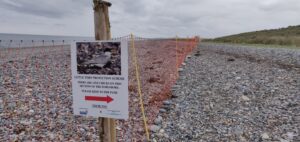
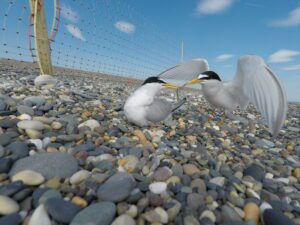 It is difficult to pinpoint why some terns arrive early. However, it is likely influenced at least in part by the Kilcoole project itself.
“Kilcoole is a reliable and successful place for them to nest, not because there is anything particularly unique about the beach, but because of the project and the level of protection it has provided to the birds for many years,” says Brian. “The most experienced terns always start nesting first and, the more experienced terns you’ve had, the earlier the season begins.”
As the rate of new eggs being laid continued apace, it was quickly becoming clear that a very large number of Little Terns had returned to Kilcoole this year.
At its peak in early June we recorded over 270 nesting pairs of Little Terns at Kilcoole. This is the highest-ever number for the project and a long way from the 14 pairs recorded at the project’s onset many years ago. Based on these figures, Kilcoole likely had one of the largest Little Tern colonies in the Ireland and Britain this year and numbers from colonies monitored and protected by Louth Nature Trust at Baltray, BirdWatch Ireland Fingal Branch in Portrane, and NPWS in Cahore all suggest healthy nesting numbers at other key Irish sites.
It is difficult to pinpoint why some terns arrive early. However, it is likely influenced at least in part by the Kilcoole project itself.
“Kilcoole is a reliable and successful place for them to nest, not because there is anything particularly unique about the beach, but because of the project and the level of protection it has provided to the birds for many years,” says Brian. “The most experienced terns always start nesting first and, the more experienced terns you’ve had, the earlier the season begins.”
As the rate of new eggs being laid continued apace, it was quickly becoming clear that a very large number of Little Terns had returned to Kilcoole this year.
At its peak in early June we recorded over 270 nesting pairs of Little Terns at Kilcoole. This is the highest-ever number for the project and a long way from the 14 pairs recorded at the project’s onset many years ago. Based on these figures, Kilcoole likely had one of the largest Little Tern colonies in the Ireland and Britain this year and numbers from colonies monitored and protected by Louth Nature Trust at Baltray, BirdWatch Ireland Fingal Branch in Portrane, and NPWS in Cahore all suggest healthy nesting numbers at other key Irish sites.
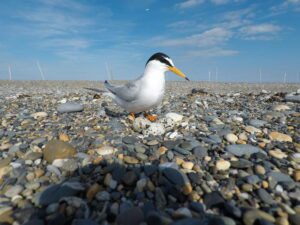 The 2024 season wasn’t all plain sailing, however.
“We had one week in June where the birds’ fortunes took a hit, unfortunately. There was some predation by Hooded Crows, who caused a lot of damage in a short space of time before the wardens could put a stop to it. A few days later, stormy weather and a sea swell at high tide took a lot of medium-sized chicks on the shoreline,” says Brian.
“If these impacts happened earlier in the season when most were still on their eggs, there would have been the time and opportunity for birds to relay. Unfortunately, because of the timing in mid-June, many of the birds were too late to try again. That was the low point of the season and the hard-hitting reality of this kind of work.”
Thankfully, things have been progressing very well since. Any subsequent predation incidents were minor and successfully managed by the colony wardens and a large number of chicks have now fledged. Some of them have already been spotted at the Little Tern conservation project at Portrane in north Dublin, and Gronant in Wales, as they explore the Irish Sea prior to migration.
The 2024 season wasn’t all plain sailing, however.
“We had one week in June where the birds’ fortunes took a hit, unfortunately. There was some predation by Hooded Crows, who caused a lot of damage in a short space of time before the wardens could put a stop to it. A few days later, stormy weather and a sea swell at high tide took a lot of medium-sized chicks on the shoreline,” says Brian.
“If these impacts happened earlier in the season when most were still on their eggs, there would have been the time and opportunity for birds to relay. Unfortunately, because of the timing in mid-June, many of the birds were too late to try again. That was the low point of the season and the hard-hitting reality of this kind of work.”
Thankfully, things have been progressing very well since. Any subsequent predation incidents were minor and successfully managed by the colony wardens and a large number of chicks have now fledged. Some of them have already been spotted at the Little Tern conservation project at Portrane in north Dublin, and Gronant in Wales, as they explore the Irish Sea prior to migration.
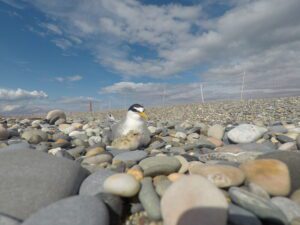
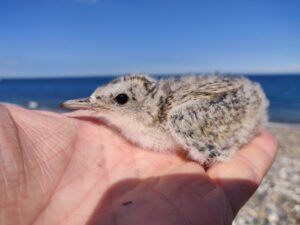 The colony has also managed to escape Avian Influenza (Bird Flu) for another year. While the nesting habits of Little Terns make them less vulnerable to Avian Flu than those that nest in mixed species, high-density colonies such as Common Terns and Roseate Terns, the potential threat of the deadly disease is never far from our minds during the breeding season.
Most of the Kilcoole Little Terns have now left the site and the few remain will soon depart, leaving Brian and the wardens behind with reports to write and reflections on another busy season!
“The lesson this year is that every year is different. We are constantly trying to control what we can control but of course, some things are uncontrollable. Overall, it's about us giving the birds more good years than bad years,” says Brian.
[Nesting Little Tern Photos by Brian Burke, taken under NPWS licence]
The Kilcoole Little Tern Project is an NPWS project run by BirdWatch Ireland under a competitive tender agreement in 2024.
The colony has also managed to escape Avian Influenza (Bird Flu) for another year. While the nesting habits of Little Terns make them less vulnerable to Avian Flu than those that nest in mixed species, high-density colonies such as Common Terns and Roseate Terns, the potential threat of the deadly disease is never far from our minds during the breeding season.
Most of the Kilcoole Little Terns have now left the site and the few remain will soon depart, leaving Brian and the wardens behind with reports to write and reflections on another busy season!
“The lesson this year is that every year is different. We are constantly trying to control what we can control but of course, some things are uncontrollable. Overall, it's about us giving the birds more good years than bad years,” says Brian.
[Nesting Little Tern Photos by Brian Burke, taken under NPWS licence]
The Kilcoole Little Tern Project is an NPWS project run by BirdWatch Ireland under a competitive tender agreement in 2024.

